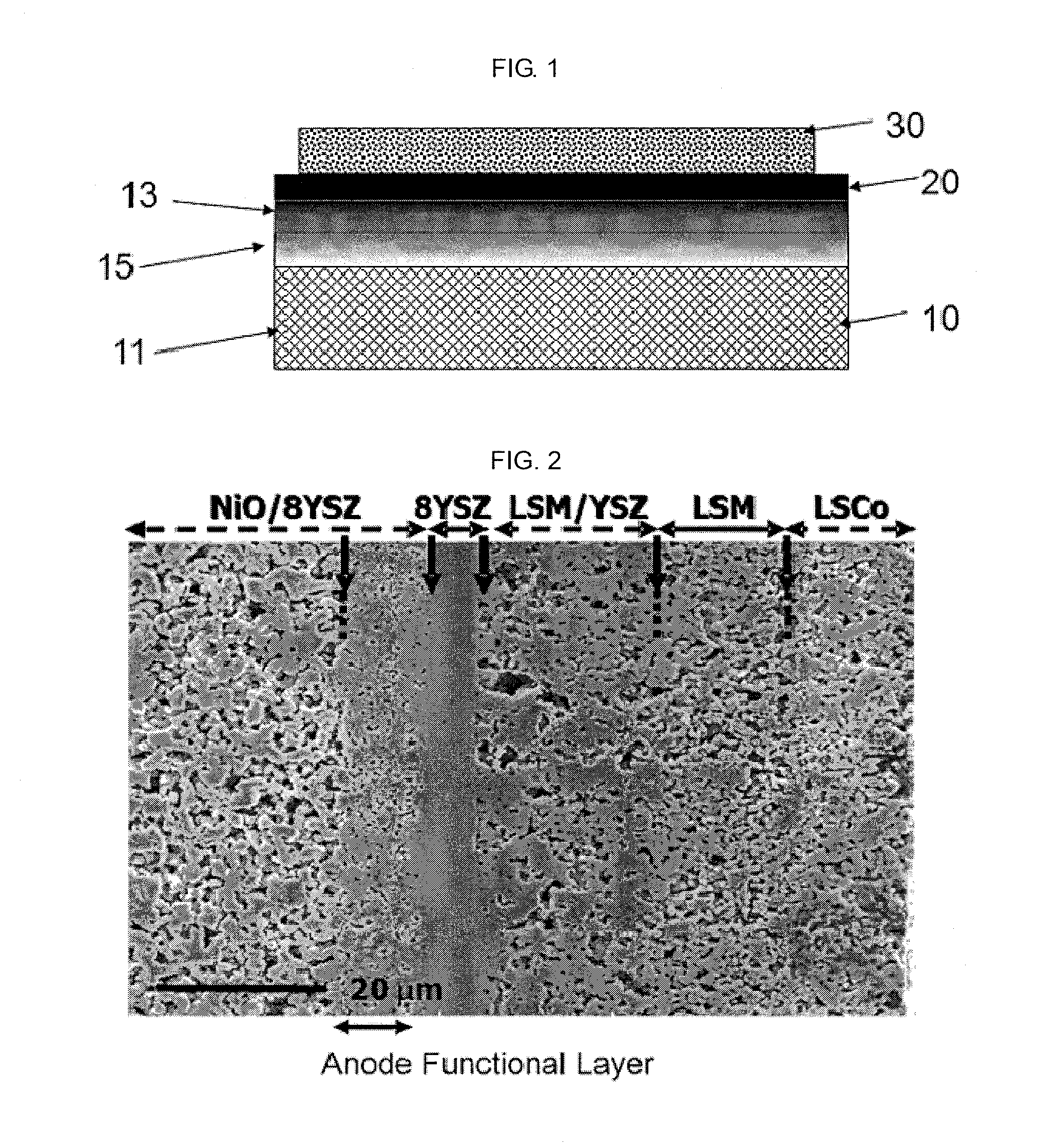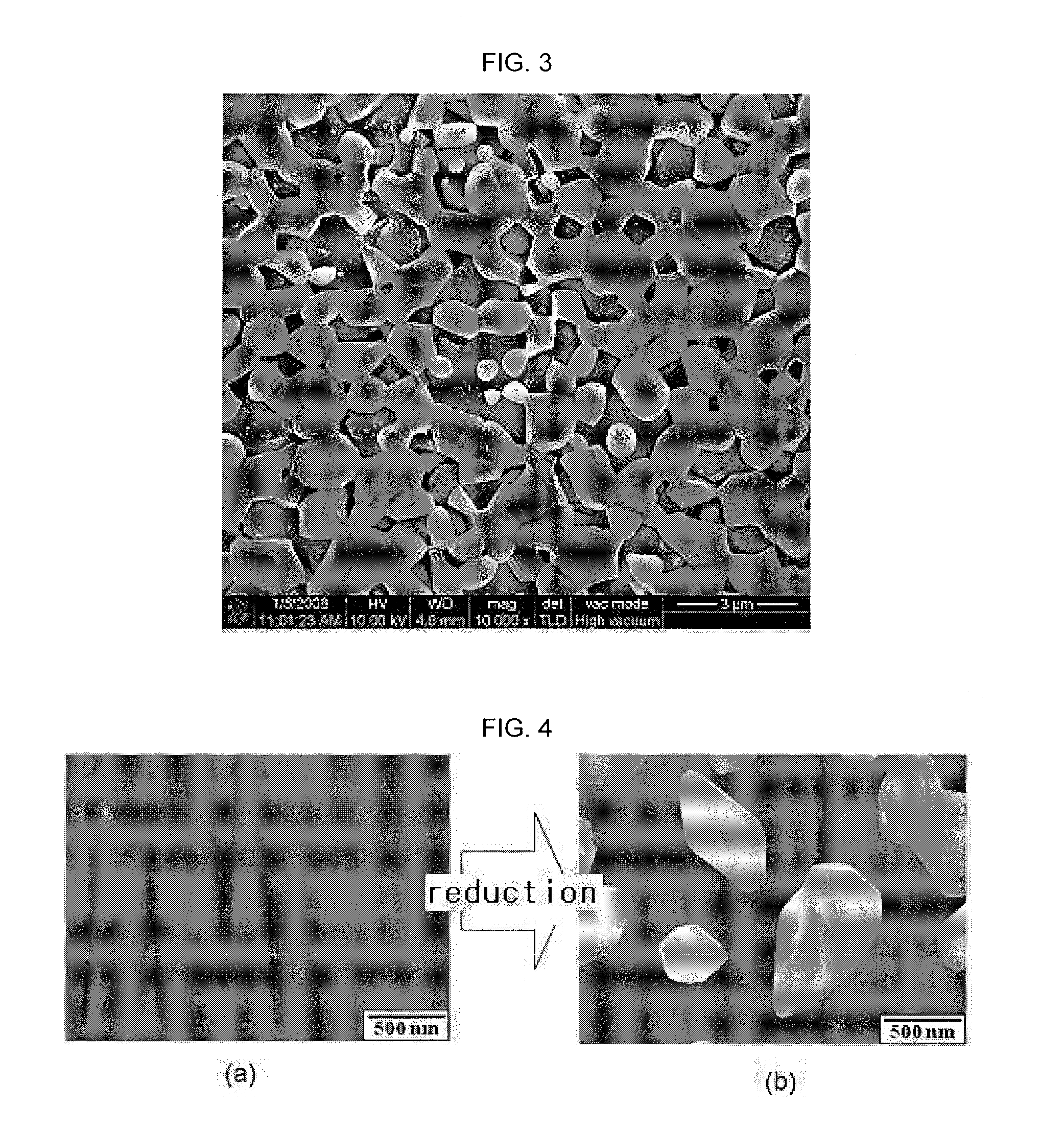Anode-supported solid oxide fuel cell comprising a nanoporous layer having a pore gradient structure, and a production method therefor
a technology of solid oxide fuel cell and nanoporous layer, which is applied in the direction of cell components, final product manufacturing, sustainable manufacturing/processing, etc., can solve the problems of membrane type fuel cell structural vulnerability, reduced performance, mechanical vulnerability, etc., and achieves excellent structural stability, high cost, and degradation of performance.
- Summary
- Abstract
- Description
- Claims
- Application Information
AI Technical Summary
Benefits of technology
Problems solved by technology
Method used
Image
Examples
example 1
[0106]Fabrication of SOFC including porous anode support fabricated through powder process and a porous anode functional layer formed on the porous anode support through vacuum deposition (two-step anode pore-gradient structure)
[0107]An NiO-YSZ tape fabricated by using a powder process is laminated and then sintered at 1300° C. for four hours to fabricate a porous anode support.
[0108]Thereafter, the temperature of the anode support was fixed to 700° C., and an NiO-YSZ target was deposited to have a thickness of about two microns on the anode support at 50 mtorr of oxygen process pressure through pulsed laser deposition (PLD).
[0109]Thereafter, the deposited NiO-YSZ thin film was post-annealed at 1200° C. The post-annealing treatment could strengthen bonding force between YSZs to prevent Ni metal from coarsening during reduction. In this process, the particle size was grown from few nm (approximately 2 nm to 3 nm) at the initial stage to a 100 nm level. FIG. 12 shows a microstructure ...
example 2
[0112]Fabrication of thin film SOFC including anode functional layer formed through vacuum deposition on a porous-anode support having a two-step gradient structure fabricated through powder process (three-step anode pore-gradient structure) and the evaluation of performance
[0113]A layer having a small size of pores, which is compared with a layer formed by pressing NiO-YSZ composite powder, pre-sintering it and forming it through common powder process, was formed through screen printing and sintered at 1400° C. for three hours to fabricate a porous anode support having a two-step porous gradient structure.
[0114]And then, the temperature of the anode support having the two-step pore-gradient structure was fixed at 700° C., and an NiO-YSZ thin film was deposited on the NiO-YSZ thin film to have a thickness of about 4 to 6 microns through pulsed laser deposition (PLD) by using the NiO-YSZ target at an oxygen process pressure of 50 mtorr and then post-annealed at 1200° C.
[0115]And then...
example 3
[0118]Fabrication of thin film SOFC including anode functional layer formed through a composite nano-powder slurry spin coating method on a porous-anode support having a two-step gradient structure fabricated through powder process, and an additional anode functional layer formed on the anode functional layer through vacuum deposition (four-step anode pore-gradient structure) and the evaluation of performance
[0119]A porous anode support having a two-step pore-gradient structure was fabricated by using the same method as that of Example 2.
[0120]Composite nano-powder used for fabricating composite nano-powder slurry in which ceramics for electrolyte and metal oxide nano-powder for electrode are dispersed was fabricated in the following manner.
[0121]As a material of NiO, Y2O3 and ZrO2, Ni(NO3)2. 6H2O (JUNSEI Co. product), Y(NO3)3. 6H2O (ALDRICH Co. product), and N2O7Zr.XH2O (ACROS Co. product) was used as an oxidizing agent of glycine-nitrate process (GNP), and glycine (H2NCH2COOH) (DA...
PUM
| Property | Measurement | Unit |
|---|---|---|
| thickness | aaaaa | aaaaa |
| thickness | aaaaa | aaaaa |
| size | aaaaa | aaaaa |
Abstract
Description
Claims
Application Information
 Login to View More
Login to View More - R&D
- Intellectual Property
- Life Sciences
- Materials
- Tech Scout
- Unparalleled Data Quality
- Higher Quality Content
- 60% Fewer Hallucinations
Browse by: Latest US Patents, China's latest patents, Technical Efficacy Thesaurus, Application Domain, Technology Topic, Popular Technical Reports.
© 2025 PatSnap. All rights reserved.Legal|Privacy policy|Modern Slavery Act Transparency Statement|Sitemap|About US| Contact US: help@patsnap.com



